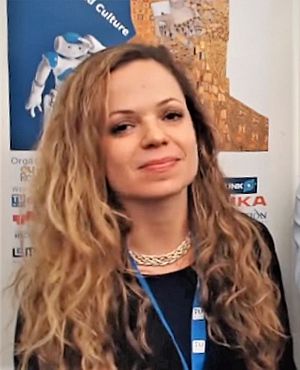Margarita Chli facts for kids
Quick facts for kids
Margarita Chli
|
|
|---|---|

Chli in 2015
|
|
| Nationality | Greek |
| Alma mater | University of Cambridge Imperial College London |
| Known for | Innovating autonomous aerial vehicles |
| Awards | 2017 Zonta Prize, 2017 Speaker at the World Economic Forum in Davos, 25 Women in Robotics You Need to Know |
| Scientific career | |
| Fields | Robotics and computer vision |
| Institutions | ETH Zürich |
Margarita Chli is a brilliant scientist who works with robots and computers. She is a professor at ETH Zürich in Switzerland. She leads a special lab called the Vision for Robotics Lab. Dr. Chli is famous for her work in making robots "see" and understand the world around them. She was part of the team that created the first helicopter that could fly all by itself! Her research helps make flying robots smarter.
Contents
Early Life and Learning
Margarita Chli grew up in Cyprus and Greece. She went to the University of Cambridge in the United Kingdom. There, she studied Information and Computer Engineering. After her first degree, she also earned her Master's degree in engineering.
In 2006, Dr. Chli went to Imperial College London for her advanced studies. She worked on making mobile robots navigate better. Her goal was to help robots process information quickly and accurately. She learned how to use vision to help robots "see" their surroundings. Her work helped robots understand where they were and create maps of new places.
Career and Robot Research
After finishing her studies, Dr. Chli joined the Autonomous Systems Lab at ETH Zürich. She helped lead the lab and taught a course on mobile robots. This course was even made available online for free!
In 2015, Dr. Chli became a professor at ETH Zürich. She moved her lab, called the Vision for Robots Lab (V4RL), there. Her lab focuses on making intelligent robots that can improve human life. They work on several exciting projects:
- SHERPA Project: This project uses smart robots to help with search and rescue missions in mountains.
- myCopter Project: This aims to design small flying vehicles for personal travel. Imagine flying from home to school!
- SFly Project: This project develops tiny flying robots that can map out unknown places.
All these projects need robots to be very smart. They must handle lots of data to "see" their environment. Dr. Chli's team uses advanced computer methods to give robots visual perception.
How Robots "See" the World
Dr. Chli's early work helped robots understand their surroundings. One big challenge is called simultaneous localization and mapping (SLAM). This means a robot needs to know its own location while also building a map of a new place.
Dr. Chli found a way to divide maps into smaller parts. This helps robots process information more efficiently. It was like breaking a big puzzle into smaller, easier pieces.
She also developed a method called BRISK. This helps robots quickly find important points in images. It's like teaching a robot to spot key details much faster than before.
The Autonomous Helicopter
While at ETH Zürich, Dr. Chli was part of an amazing team. They created the first small helicopter that could fly completely by itself! This helicopter used only a camera to "see." It could navigate new places and map them out on its own. This was a huge step for robot flight.
Dr. Chli has also worked on making robots navigate better. She helped create a system called MultiSensor-Fusion Extended Kalman Filter (MSF-EKF). This system helps robots combine information from many different sensors. It's like giving a robot many eyes and ears that work together. This helps robots understand their position and surroundings very accurately.
She also explored how multiple robots can work together. Imagine a team of drones mapping a large area. Each drone has a small map, and they all share information with a central computer. This way, they can build a complete map much faster. This is called multi-robot collaborative SLAM.
Recently, Dr. Chli has been using special computer programs called convolutional neural networks (CNNs). These help robots recognize places better. It's like teaching a robot to remember a specific street or building. This makes robot navigation even more reliable.
Awards and Recognitions
Dr. Chli has received many honors for her important work:
- 2017 Zonta Prize
- 2016 Named one of "25 Women in Robotics You Need to Know"
- 2016 International Conference on Robotics and Automation Best Associate Editor Award
- 2001-2005 Scholarship for outstanding qualifications, Trinity College, University of Cambridge, UK
- 2001-2005 Scholarship for outstanding performance, Cyprus State Scholarship Foundation

